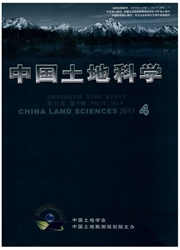

 中文摘要:
中文摘要:
研究目的:探讨不同类型农户退地决策及重要影响因素。研究方法:以重庆市实地调查数据,运用B-Logistic模型进行定量分析。研究结果:(1)户主年龄、家庭主要成员参加新农保、承包地面积对纯农户土地退出决策产生显著正向影响,而家庭劳动力数量、宅基地面积、承包地质量对纯农户土地退出决策产生显著负向影响;(2)家庭劳动力数量、家庭年均收入、家庭年均农业收入、宅基地面积、承包地质量、所在村距城镇距离对I兼农户土地退出决策产生显著负向影响,而家庭主要成员参加新农保则对I兼农户土地退出决策产生显著正向影响;(3)家庭年均收入、家庭年均非农收入对II兼农户土地退出决策产生显著正向影响,而农房造价对II兼农户土地退出决策产生显著负向影响;(4)家庭年均收入、家庭年均非农收入、所在村距离城镇距离均对非农户土地退出决策产生显著正向影响;(5)总体来看,影响纯农户与I兼农户的土地退出决策的因素具有较大相似性,而影响II兼农户与非农户的土地退出决策的因素也具有较大相似性。研究结论:不同类型农户土地退出决策及影响因素存在显著差异,地方政府有必要制定差别化的退地政策,鼓励与引导II兼农户与非农户退出土地。
 英文摘要:
英文摘要:
The purpose of this paper is to analyze the decisions of different farmers' household to return their contractual land. The method of this paper is to apply the B-Logistic model to analyze basing on the survey data of Chongqing. The results showed that 1 )age of farmers' household head, the main family members to participate in the new agricultural insurance, the contract farmland area have a significant positive effect on the decisions of the real farmers' households to return lands, however, the number of family labor, homestead area, the quality of contracted farmland have a significant negative effect on the decisions of the real farmers' households to return lands. 2)The numbers of family labor, the average annual household income, average family farm income, homestead area, the quality of contracted land, the distance that the village from the town have significant negative effect on decisions of the type I of farmers' households to return land. While, the main family members to participate in the new agricultural insurance have significant positive effect on the decisions of the type I of farmers' households to return land. 3) Housing costs have significant negative effect on the decisions of the type lI farmers' households to return lands. However, the average annual family income, average family farm income have a significant positive effect on the decisions of the type II farmers' households to return land. 4)The distance that the village from the town, the average annual family income, average family farm income has a significant positive effect on the decisions of the non-farmers' households to return land. 5) Overall, the factors that influence the real and type I farmers' households have greater similarity, and the factors that influence the non and type II farmers' households have greater similarity. The conclusion is that the impact factors on returning land are significant different. The local government should put forward policies to encourage and guide the type I
 同期刊论文项目
同期刊论文项目
 同项目期刊论文
同项目期刊论文
 期刊信息
期刊信息
